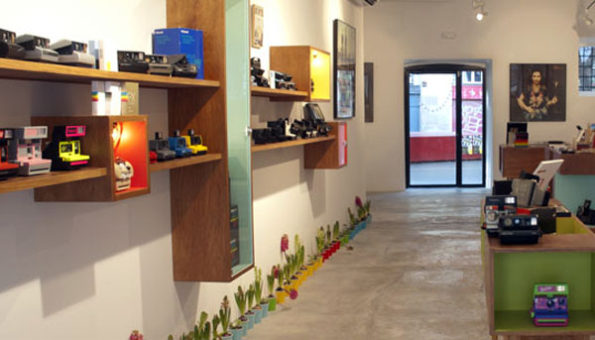Search
To search for an exact match, type the word or phrase you want in quotation marks.
A*DESK has been offering since 2002 contents about criticism and contemporary art. A*DESK has become consolidated thanks to all those who have believed in the project, all those who have followed us, debating, participating and collaborating. Many people have collaborated with A*DESK, and continue to do so. Their efforts, knowledge and belief in the project are what make it grow internationally. At A*DESK we have also generated work for over one hundred professionals in culture, from small collaborations with reviews and classes, to more prolonged and intense collaborations.
At A*DESK we believe in the need for free and universal access to culture and knowledge. We want to carry on being independent, remaining open to more ideas and opinions. If you believe in A*DESK, we need your backing to be able to continue. You can now participate in the project by supporting it. You can choose how much you want to contribute to the project.
You can decide how much you want to bring to the project.

The relationship between the market and the non-digital image reveals an interesting paradox: a technophile world dominated by nostalgia for the analogical. An obsession with the past dominates a large part of today’s cultural tendencies and consumer fashions. Where does the attraction for the obsolete lie?
As a way of explaining the current obsession with the obsolete, contemporary discourses to a large extent resonate with the ideas of Benjamin. They rush to offer theories that reaffirm the past as a source of forgotten potential, capable of providing security in the face of an uncertain future. Equally in the aesthetic field, the debates in force recall this need for resistance in the face of the most imminent future. The future presents itself as empty and ambiguous, lacking any real possibilities for development. And the present, like a vast field, that has already been explored, where all the options and surprises have run out. Looking towards the future was replaced with a general incomprehension about the changes that are rapidly taking place in society. This is when the past, in the form of emotional, formal, aesthetic and ideological baggage, ends up being a resource that lends meaning to a world that is moving too fast. The irony being that a society, that so avidly wants to progress, looks constantly to the past in search of inspiration and new forms of consumerism.
When obsolescence enjoyed its independence with regard to the system, nostalgia was still real and not an advertising tool. But it didn´t take long for it to become yet another strategy for marketing and mass culture, leaving aside its true emotional background. Its components were fragmented into decontextualized nonsense, on the whole superficial and focussed more on aesthetic /objective values than on content. The critical sense of the obsolete, as a form of resistance, ended up being ruined by changes in the policies of production, which responded to the maxim that nothing – not even art – is beyond capitalism.
Technology, the pampered child of capitalism, finds an honourable rival in this analogical nostalgia but at the same time a powerful ally, that in part offers an explanation for the current paradox. We find ourselves in a strange intermediate stage, charmed by the gleaming lights of technological progress and at the same time immobilised by anti-digital impulses. For however uncertain the future may be, the most immediate present seems contaminated and invaded by an accelerated overproduction of new consumer articles. Present options are almost infinite, but not one opens a true breach into the future. It is a complex quandary which marketing has known how to squeeze dry in a masterly fashion: the past, as part of the capitalist structure, dominates the present, as an element of reconfiguration capable of granting added value to an existence lacking any real innovation. To understand the link between the market and non-digital images we need to begin by accepting the existence of “programmed obsolescence” as an integral part of the consumer system.
Audacious and unflagging marketing takes on our pathologies, redressing them with a new, radiant, agreeable nature. It stresses the reminiscence about the beautiful memory and its aesthetic, creating a reformulated vision that provokes a sweetened nostalgia, but above all, one that is commercial, marketable and exploitable. We are talking about a programmed yearning, a consumer retro-mania driven by a few subtly implanted ideas. For its part, art converted into a product for the masses by the culture industry gathers in these advertising tendencies offering a form of leisure in accord with the consumer world that surrounds it. It is here where marketing enters into a cosmos that is very close to the artistic. In the same way as it plays with our feelings to sell, art uses them to express and transmit aesthetic ideas that provoke critical thought. Despite the distances between them, their use of emotions is not as different as one might expect.
To evoke the past always ends up being useful to control and provoke a series of reactions in the public, be it as a spectator or as a potential client. The marketing of nostalgia is as complex as the feelings it endeavours to control and at the same time provoke. As an exhibition concept it is irredeemably linked to discourses about memory, where everything that came before is patrimony. The past becomes an element that can be placed in a museum in an emotive manner, capable of evoking the times abandoned due to progress, the deterioration and crisis presumed by our contemporaneity. The exhibition at MACBA Centre Internacional de Fotografía Barcelona (1978-1983), shows the production of photography during the Transition, in the local context of Barcelona. The seventies and eighties are the “new” golden Spanish age, the nostalgia for it, for its lost potential, being something we frequently try to evoke. The exhibition reclaims this era as a time of possibilities for photography, one that was truncated by history. A chapter worthy of remembering, that sheds light on the present, a tale with a revolutionary flavour and a certain didactic mode for contemporary culture.
Maybe the use of nostalgia is also a question of visual coherence. The analogical is characterised by a form of narrating that values not just the presence of the hand of man, as in any manual and analogical process, but also its imperfections as an integral part of reality. The vision of the immaculate and hyper-detailed world that the digital image offers doesn´t fit the everyday perception of a world abandoned to a more or less contained chaos. Its imperfection concords with the realistic perception of society today, despite the fact that technology and its infinites possibilities for improvement ought to be the most obvious response. Two evident examples are the fever for Lomography and the recuperation of Polaroid. Both cases present the rescuing of photographic techniques by commercial industry. Lomo represents the revival of the concept of a totally analogical photographic camera, the new charm of which resides in its limited technological qualities and total lack of precision. An object commercialised in museum shops, as a pseudo-collectors item. On the other hand, The Impossible Project presents this analogical tendency rescued by way of a well-orchestrated marketing strategy. It doesn´t merely allude to the possible total loss of a way of conceiving the photographic act, such as the Polaroid, appealing directly to feelings, but also brings itself up to date by presenting an image more in accord with the times, appealing to the consumer impulse. A powerful combination of past and present, all in a little box.
Maybe this will be the salvation of the non-digital image, the goldmine that marketing has known how to pinpoint. However, to what extent is analogical photography valued beyond just its retro aesthetic? It is hard to discern on the whole if it is a true rescue or an orchestrated combination of different elements, decontextualized and agglutinated under a new image, normally driven by “alternative” publicity. By any means, the fashion for digital images with an analogical look, a true hybrid, the fruit of nostalgia in the middle of this technological chaos, a direct heir of lomography, is the cause of a tendency that is sweeping across certain sectors. Its direct manifestation appears in the applications that allow us to create photographs easily, applying filters with just a click, with a mobile device. One could mention not just Instagram, the most famous option, but an endless list of apps and plug-ins for diverse programmes. An extreme simplification of the paradox that forms part of society. But it is not just about becoming a skilful photographer, in an analogical art, with an alarming ease, so much as the real aim is to be able to relate our lives through an analogical aesthetic, granting it the very melancholy of a time past, converting moments of the present into instantaneous memories.
The antiquated is renewed, reintegrated into the very logic of consumerism, glowing with a modernity that is halfway between the past and the present. Modern it obviously is, in a purely commercial sense. However, it is also modern in the sense that it is capable of integrating the contemporary art scene, for its supposedly authentic aesthetic and its atemporal discourse. In any of the two contexts, programmed obsolescence is by its own right the alternative to the contemporary. It is a true anti-digital impulse.

Verónica Escobar Monsalve is a restless soul, with a digital nature and an analogue heart. Her investigations centre on art and culture that mix the digital world with pre-digital thought. Art and culture that is capable of reflecting the complexity of today’s world. She believes in the vital importance of a critical spirit and how this can be applied to any facet in life, however difficult it may be.
"A desk is a dangerous place from which to watch the world" (John Le Carré)